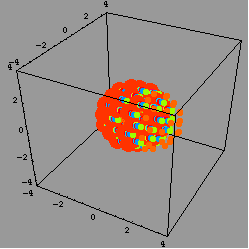Coulomb explosion

A Coulombic explosion is a
Mechanism
A Coulombic explosion begins when an intense
The laser must be very intense to produce a Coulomb explosion. If it is too weak, the energy given to the electrons will be transferred to the ions via electron-phonon coupling. This will cause the entire material to heat up, melt, and thermally ablate away as a plasma. The end result is similar to Coulomb explosion, except that any fine structure in the material will be damaged by thermal melting.[1]
It may be shown that the Coulomb explosion occurs in the same parameter regime as the superradiant phase transition i.e. when the destabilizing interactions become overwhelming and dominate over the oscillatory phonon-solid binding motions.[citation needed]
Technological use
A Coulomb explosion is a "cold" alternative to the dominant
Coulomb explosions for industrial machining are made with ultra-short (
Appearance in nature
High speed camera imaging of alkali metals exploding in water has suggested the explosion is a coulomb explosion.[3][4]
During a
Scientists at the University of Cologne Zoological Institute have suggested that coulomb explosion (specifically, the electrostatic repulsion of dissociated carboxyl groups of polyglutamic acid) may be part of the explosive action of nematocytes, the stinging cells in aquatic organisms of the phylum Cnidaria.[7]
Coulomb Explosion Imaging
Molecules are held together by a balance of charge between negative electrons and positive nuclei. When multiple electrons are expelled, either by laser irradiation or bombardment using highly charged ions, the remaining, mutually repulsive, nuclei fly apart in a Coulomb explosion. The structure of simple gas phase molecules can be determined by imaging which tracks the fragment trajectories.[8][9] As of 2022 the method can work with up to 11-atom molecules.[10][11]
See also
References
- PMID 19654716.
- ^ Müller, D. (November 2009). "Picosecond Lasers for High-Quality Industrial Micromachining". Photonics Spectra: 46–47.
- PMID 25698335.
- ^ "Sodium's Explosive Secrets Revealed". Scientific American. 27 Jan 2015.
- ISBN 9780160591341.
approximately 82% of the fission energy is released as kinetic energy of the two large fission fragments. These fragments, being massive and highly charged particles, interact readily with matter. They transfer their energy quickly to the surrounding weapon materials, which rapidly become heated
- ^ "Nuclear Engineering Overview" (PDF). Technical University Vienna. Archived from the original (PDF) on May 15, 2018.
The various energies emitted per fission event pg 4. "167 MeV" is emitted by means of the repulsive electrostatic energy between the 2 daughter nuclei, which takes the form of the "kinetic energy" of the fission products, this kinetic energy results in both later blast and thermal effects. "5 MeV" is released in prompt or initial gamma radiation, "5 MeV" in prompt neutron radiation (99.36% of total), "7 MeV" in delayed neutron energy (0.64%) and "13 MeV" in beta decay and gamma decay(residual radiation)
- .
- S2CID 39373145.
- S2CID 250782825.
- S2CID 247047286.
- S2CID 247826394.
